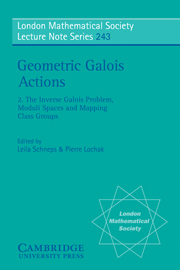Book contents
- Frontmatter
- Contents
- Introduction
- Abstracts
- Part I Dessins d'enfants
- Unicellular cartography and Galois orbits of plane trees
- Galois groups, monodromy groups and cartographic groups
- Permutation techniques for coset representations of modular subgroups
- Dessins d'enfants en genre 1
- Part II Inverse Galois problem
- Part III Galois actions, braids and mapping class groups
- Part IV Universal Teichmüller theory
- Errata for Tame and stratified objects
Permutation techniques for coset representations of modular subgroups
Published online by Cambridge University Press: 04 May 2010
- Frontmatter
- Contents
- Introduction
- Abstracts
- Part I Dessins d'enfants
- Unicellular cartography and Galois orbits of plane trees
- Galois groups, monodromy groups and cartographic groups
- Permutation techniques for coset representations of modular subgroups
- Dessins d'enfants en genre 1
- Part II Inverse Galois problem
- Part III Galois actions, braids and mapping class groups
- Part IV Universal Teichmüller theory
- Errata for Tame and stratified objects
Summary
Introduction
We recall that dessins d'enfants may be considered as one of the following equivalent classes of objects. Let G be an appropriate “cartographical”group. (We may take G = Γ(2) for general dessins, G = Γ0(2) for pre–clean dessins, and G = PSL2 (ℤ) for pre-clean dessins whose valencies atthe “other” type of vertex divide 3.)
Coverings of the Riemann sphere, branched (in a manner consistent with G) only above {0, 1,∞}, along with a choice of (unramified) basepoint.
Drawings (structured in a manner consistent with G) on connected oriented surfaces.
Subgroups of G.
Transitive permutation representations of G, along with a choice of basepoint.
The correspondences among these classes of objects have been explained many times, so we refer the reader to Birch [2], Jones and Singerman [5],and Schneps [7] for details, mentioning only one piece of terminology: In describing the correspondence between (3) and (4), we call the basepointed transitive permutation representation of G corresponding to a subgroupG1 ≤ G the coset representation of G1 as a subgroup of G.
This article describes some computational methods for working with dessins and similar structures. Briefly, one might say that the questions examined here arise from subgroups (viewpoint (3)), and the answers come from looking at their coset representations (viewpoint (4)). We hope that the methods presented here can be used to address other questions about dessins by looking at them in terms of their coset representations.
- Type
- Chapter
- Information
- Geometric Galois Actions , pp. 67 - 78Publisher: Cambridge University PressPrint publication year: 1997

